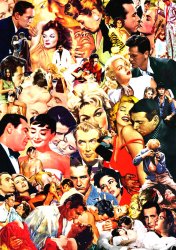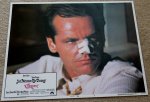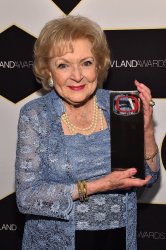 Jack Nicholson once gave the following screen acting advice to Harry Dean Stanton: “Just let the wardrobe be the character. You play yourself. That’s the way you approach it.” Jack Nicholson is a three time Oscar® winner, 12 time nominee and the star of classic films such as The Shining, Chinatown and One Flew Over the Cuckoo’s Nest. On the other hand, Ian McKellen once commented, “Acting is a very personal process. It has to do with expressing your own personality, and discovering the character you’re playing through your own experience – so we’re all different.” What I’ve laid out are two completely different approaches to film acting. One is the argument that to be a good film actor, you only must be present and being yourself, with a little charm and charisma is enough to be successful on screen. The likes of Cary Grant, Gary Cooper, Clark Gable and William Powell might be examples of this school of thought. The other argument is one more associated with actors who participate more in the theater, in believing that a successful film actor takes more than presence, it takes an ability to express emotions and portray someone different than yourself. The likes of Pacino, De Niro, Duvall and Nicholson exemplify this. That’s where the great debate lies.
Jack Nicholson once gave the following screen acting advice to Harry Dean Stanton: “Just let the wardrobe be the character. You play yourself. That’s the way you approach it.” Jack Nicholson is a three time Oscar® winner, 12 time nominee and the star of classic films such as The Shining, Chinatown and One Flew Over the Cuckoo’s Nest. On the other hand, Ian McKellen once commented, “Acting is a very personal process. It has to do with expressing your own personality, and discovering the character you’re playing through your own experience – so we’re all different.” What I’ve laid out are two completely different approaches to film acting. One is the argument that to be a good film actor, you only must be present and being yourself, with a little charm and charisma is enough to be successful on screen. The likes of Cary Grant, Gary Cooper, Clark Gable and William Powell might be examples of this school of thought. The other argument is one more associated with actors who participate more in the theater, in believing that a successful film actor takes more than presence, it takes an ability to express emotions and portray someone different than yourself. The likes of Pacino, De Niro, Duvall and Nicholson exemplify this. That’s where the great debate lies.
Throughout this blog I will refer to the first argument as presence and to the second as portrayal. If you notice, the examples of actors who fall under the presence category are all stars from the Golden Age of Hollywood. Which is to say that is the style most popular during that era.
Film acting, at that time in America, wasn’t necessarily thought of as something deep and internal. It was simply a matter  of being marketable and was a part of successful films. Of course there were exceptions such as Fredric March, Laurence Olivier and Claude Rains. But the biggest money makers, such as Bogart and Cagney. While they may have started their careers in theater, once they became film stars they never went back.
of being marketable and was a part of successful films. Of course there were exceptions such as Fredric March, Laurence Olivier and Claude Rains. But the biggest money makers, such as Bogart and Cagney. While they may have started their careers in theater, once they became film stars they never went back.
Those actors, even though they lacked the talents of a thespian, made millions. They were stars, and they starred in the films we consider classics today. Films such as The Maltese Falcon, Casablanca, Gone With the Wind and His Girl Friday. You’ll notice that the supporting players are the true thespians. That’s because, at that time, to be a leading man or woman wasn’t about your talent as an actor with a deep process. It was about making money and bringing people to the theater to see beautiful, extravagant people. The studios didn’t want actors, they wanted stars. People to fawn over, people with charisma and charm. They didn’t want deep, emotional experiences. The y wanted to witness the fantastic – wonderful costumes, extraordinary stories, and attractive actors were the order of the day. This meant, for actors like Sydney Greenstreet and Thomas Mitchell, there were no starring roles in major pictures for them. But they could bet on a supporting actor nomination or even a win.
y wanted to witness the fantastic – wonderful costumes, extraordinary stories, and attractive actors were the order of the day. This meant, for actors like Sydney Greenstreet and Thomas Mitchell, there were no starring roles in major pictures for them. But they could bet on a supporting actor nomination or even a win.
Nonetheless, that style of thinking within the studio system lasted until Brando came on th e scene. Then, the actors of old condemned the new style. We know it as “method acting.” Gary Cooper called method actors “a bunch of goof balls.” Spencer Tracy said he was “too old, too tired and too talented to care.” Then again, Tracy approached acting as easily as “knowing your lines and don’t bump into the furniture.”
e scene. Then, the actors of old condemned the new style. We know it as “method acting.” Gary Cooper called method actors “a bunch of goof balls.” Spencer Tracy said he was “too old, too tired and too talented to care.” Then again, Tracy approached acting as easily as “knowing your lines and don’t bump into the furniture.”
But amidst the Brando and Deans of the Golden Age, characterization in the world of film acting wasn’t something desired by audiences until the New Wave came along in the late 60s. Realism was the order of the day and that’s where Ian McKellen’s quote I mentioned earlier came into play. Actors such as Dustin Hoffman and Al Pacino came on the scene and offered audiences a new type of movie star – the kind that won Oscars for more than being the box-office star, but because they delivered a wonderful performance of emotional stature. No longer was the d ashingly handsome or exceptionally beautiful actor necessary. Now don’t get me wrong, box office stars still included the likes of Robert Redford and Warren Beatty, but even short, off-beat Dustin Hoffman could draw in crowds. That was new. For even in the Golden Age, method actors Paul Newman and Marlon Brando were exceptionally attractive. But now, at the dusk of that classic era, character actors could now lead movies.
ashingly handsome or exceptionally beautiful actor necessary. Now don’t get me wrong, box office stars still included the likes of Robert Redford and Warren Beatty, but even short, off-beat Dustin Hoffman could draw in crowds. That was new. For even in the Golden Age, method actors Paul Newman and Marlon Brando were exceptionally attractive. But now, at the dusk of that classic era, character actors could now lead movies.
That trend has trickled into today. Interestingly enough, it’s still an attractive actors’ medium as far as major motion pictures go. Dwayne Johnson, Chris Hemsworth, Zac Efron and such still fit that stereotypical “leading man” criteria. The only difference is that they aren’t the ONLY ones leading films that are seen and acclaimed. If Claude Rains led a film in his day, it wouldn’t be an “indie film”, it’d be a B movie – just another film to keep the machine running. But there would be no awards’ traction, no sort of acclaim. In today’s film culture, a character acto r can be supporting in a major picture and lead their own indie film.
r can be supporting in a major picture and lead their own indie film.  Take Paul Giamatti for example, he’s not anything like a leading man type. But Sideways is a film he leads beautifully and he got plenty of awards’ notice. But he’s great at the job that pays him, being the supporting actor in films like San Andreas, Cinderella Man and The Amazing Spider-Man 2.
Take Paul Giamatti for example, he’s not anything like a leading man type. But Sideways is a film he leads beautifully and he got plenty of awards’ notice. But he’s great at the job that pays him, being the supporting actor in films like San Andreas, Cinderella Man and The Amazing Spider-Man 2.
The debate lies in, “is someone like Cary Grant a better film actor than someone like Philip Seymour Hoffman?” Cary Grant starred in the some of the most beloved films of all time – North by Northwest, To Catch a Thief and An Affair to Remember. Philip Seymour Hoffman has given versatile performances such as his performances in The Master, Punch-Drunk Love and Doubt. The first examples are all time acclaimed films, but Cary Grant doesn’t show much versatility. The next examples are acclaimed performances, but the films themselves aren’t considered classic by the masses. So who do you consider better? Perhaps it depends on who you are. The new generation of critics and movie buffs will say Hoffman easily. But classic movie fans will surely say Grant. What matters more to you? The presence of the actor or the portrayal by the actor?
 There is nothing like a good futuristic story. It may include spaceships, teleportation, invisibility, lasers or just your good old giant robot fight. For many decades, this futuristic tech has been the things of fiction. Recently, that is changing. The objects in films like Star Wars, or Star Trek, or even Transformers are actually becoming part of our everyday life. In Japan, there are robots that have become so advanced and so powerful, they could replace a soldier. Across Europe and North America, there is development of cleaner and much more powerful electricity production and in many nations, space is a big topic again.
There is nothing like a good futuristic story. It may include spaceships, teleportation, invisibility, lasers or just your good old giant robot fight. For many decades, this futuristic tech has been the things of fiction. Recently, that is changing. The objects in films like Star Wars, or Star Trek, or even Transformers are actually becoming part of our everyday life. In Japan, there are robots that have become so advanced and so powerful, they could replace a soldier. Across Europe and North America, there is development of cleaner and much more powerful electricity production and in many nations, space is a big topic again. will we still have sci-fi as we know it now? Most likely, in 100 years, all that technology that we never thought could be possible, will be part of our day to day life. Most likely, sci-fi will either become a much different genre with technology than we believe is simply impossible to exist, like immortality, or magical production that pops anything out of nothing. Another possibility is that in a very ironic way, the imagination that the sci-fi genre sparks will be the one that kills it at the end since, as a human race, we focus on making such a world come to life (even if that world is a good or bad one) and thus, it will cause the death of sci-fi as a movie genre. What do you think?
will we still have sci-fi as we know it now? Most likely, in 100 years, all that technology that we never thought could be possible, will be part of our day to day life. Most likely, sci-fi will either become a much different genre with technology than we believe is simply impossible to exist, like immortality, or magical production that pops anything out of nothing. Another possibility is that in a very ironic way, the imagination that the sci-fi genre sparks will be the one that kills it at the end since, as a human race, we focus on making such a world come to life (even if that world is a good or bad one) and thus, it will cause the death of sci-fi as a movie genre. What do you think?









